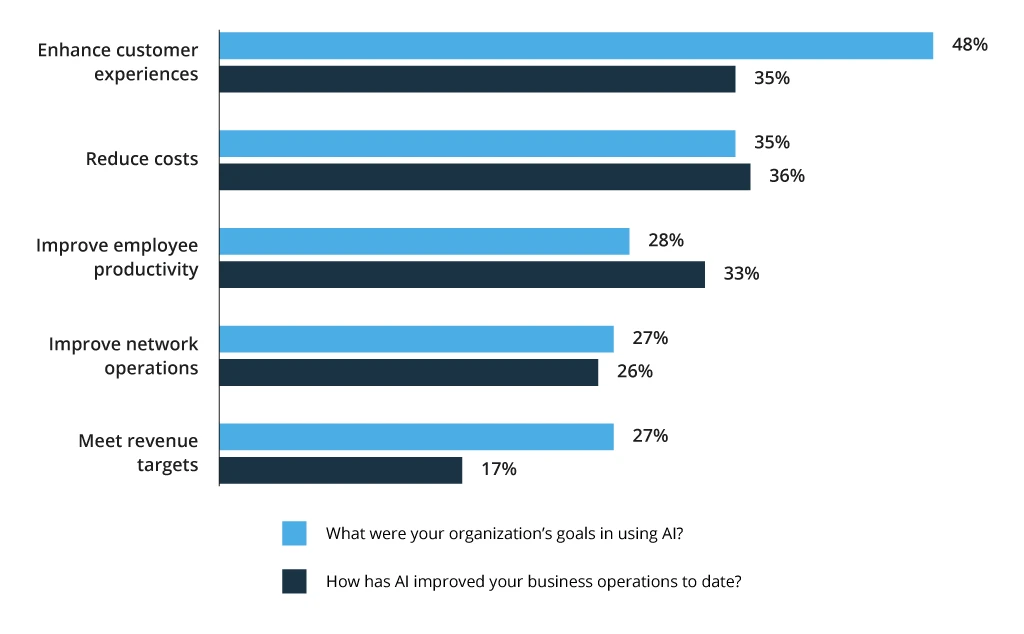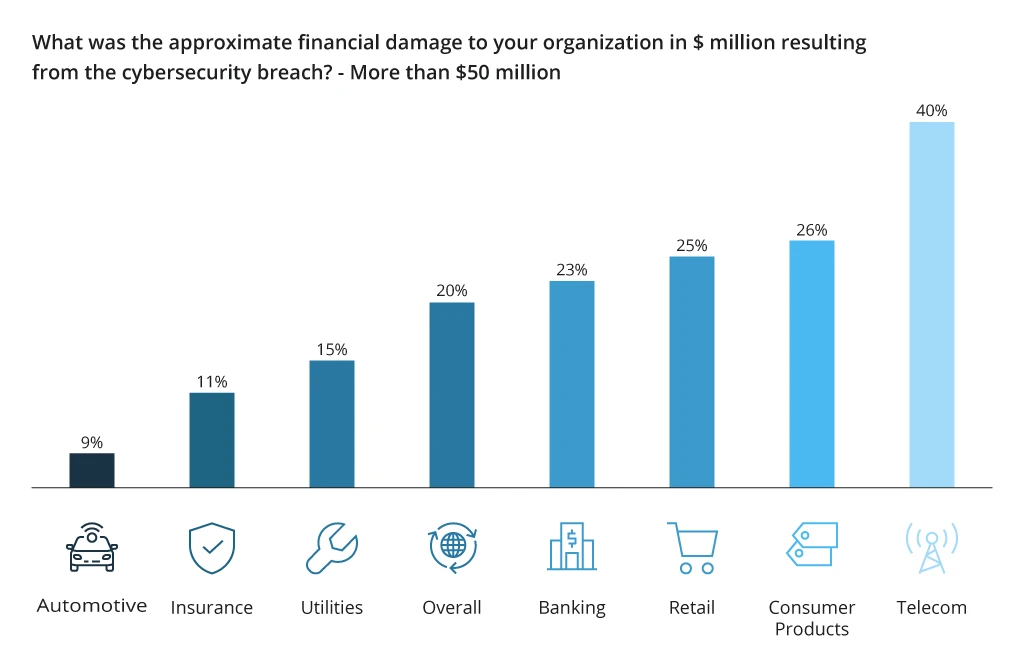Empowering Telecom Industry with Artificial Intelligence
Over the next five years, as more people use 5G and telecom companies update their networks, things will get more complicated. Even though there's a lot happening in the digital landscape, available budgets stay the same, prompting tech executives to do more with less. In this situation, Telco Artificial Intelligence becomes really important to make the most of what's already there. We anticipate networks growing by 73%, which is more than five times the rate in the past five years.
Let’s explore the opportunities and advantages that artificial intelligence may bring into telecommunications in the nearest future.
Swift and Secure Network Performance with Artificial Intelligence
Modern networks are becoming more sophisticated, while their management systems are still comprised of manual and repetitive tasks. Artificial Intelligence can significantly optimize the key aspects of telecom network management by making them more swift and efficient. AI is able to accurately monitor the network performance and instantly disclose errors, detect their root cause, and relay this data to operators.
Furthermore, advanced AI algorithms can safeguard the telecom network from traffic overload and immediately respond to it. To avert the needless overload, AI may be amped up with another emerging technology – Network Function Virtualization (NFV). The latter eliminates the need for custom hardware, using virtual machines to run network services on top of standard servers. Besides traffic overload detection, AI will be able to funnel traffic through virtual machines by means of NFV without any human engagement. Such automation can accelerate network performance and prominently simplify its management.
Case in point: Infopulse assisted the global voice carrier BICS with the migration to a Big Data platform for real-time analysis and optimized network capacity. The solution resulted in a 50% decrease in data analysis time, improved management of massive data volumes, and successful support for diverse data processing use cases such as IoT, MVNO/MVNE, and billing.
- Traffic Prediction and Resource Allocation: AI algorithms can analyze historical data and current network conditions to predict potential traffic spikes.
- Automated Load Balancing: AI algorithms continuously monitor network traffic patterns and distribute loads across virtualized network functions.
- Quality of Service (QoS) Optimization: AI algorithms analyze real-time data to identify network bottlenecks and optimize QoS parameters.
Telecom entrepreneurs are already investing heavily in artificial intelligence to boost network efficiency. According to NVIDIA's "State of AI in Telecommunication" survey, an overwhelming 95% of telecom respondents are using AI. The main focus of AI deployment is on network operations monitoring and management, as shown in the graph below.
Benefits of AI-Driven Predictive Maintenance in Telecommunications
The overwhelming majority of contemporary telecom enterprises use two common maintenance approaches for their telecom infrastructure maintenance:
- Preventive maintenance uses statistical process control based on the pre-established criteria to identify the appropriate time for maintenance. Yet, such an approach has a very low probability of detecting unexpected risks, which may result in system unavailability and significant revenue losses. For instance, customers may interpret frequent scheduled maintenance activities as indicative of network unreliability. Or unforeseen disruptions can result in revenue losses, resulting from customer dissatisfaction and potential SLA breaches.
- Corrective maintenance comes into action only after the equipment has stopped working. Consequently, utilizing this maintenance method results in high operating expenses.
AI-driven predictive maintenance surpasses traditional methods in efficiency thanks to access to historical data, and advanced algorithms that use it to foresee unexpected faults. AI systems continuously monitor equipment, promptly alerting operators to potential errors, making predictive maintenance cost- and time-efficient compared to corrective approaches.
Recognized for its versatility, artificial intelligence serves as a powerful and precise tool for maintaining various telecom equipment, from cell towers and generators to power lines and data centers.
AI-driven predictive maintenance use cases:
- Network Equipment Health Monitoring: AI algorithms continuously analyze data from network components such as routers, switches, and servers.
- Anticipating Fiber Optic Cable Failures: AI analyzes historical data related to fiber optic cables, considering factors like stress, environmental conditions, and usage patterns.
- Fault Prediction in Data Centers: AI algorithms assess data center conditions, including server loads, cooling systems, and power distribution.
Enhancing Telecom Customer Experience with AI Chatbots and Virtual Assistants
Telecom companies, grappling with high call volumes and customer inquiries, often struggle to maintain efficient 24/7 human support. To address this, AI-based chatbots emerge as a swift and resource-efficient solution, adept at handling diverse customer issues in real-time for internet and mobile services. Anchored in natural language processing (NLP) and machine learning algorithms, these chatbots streamline customer support tasks with a wide range of capabilities:
- Customer support and FAQs
- Service activation and configuration
- Billing and account management
- Basic device troubleshooting
Tireless and ready to serve 24/7, chatbots help businesses by automating up to 75% of 1st line support. However, they should not be confused with a more sophisticated piece of technology – Virtual Assistants
Virtual Assistants (VA) leverage advanced AI technologies, including deep learning, neural networks, and sophisticated NLP engines. They are designed to understand complex user queries, maintain context over extended interactions, and execute multifaceted tasks.
VAs are designed on the basis of advanced AI technologies – deep learning and neural networks. Compared to chatbots, virtual assistants have a more robust natural language processing (NLP) and natural language understanding (NLU) engines, which allows them to preserve the context of the conversation, resulting in more efficient and flexible interactions with the customers.
Most
importantly, VAs are able to adapt to individual user needs and preferences,
offering relevant personalized services that improve customer satisfaction and
loyalty, such as:
- Advanced technical support
- Accessing information from various sources
- Appointment scheduling and service requests
- User onboarding and education on various services, features, and usage tips
The recent surge in generative AI is swiftly transforming telecom. Unlike traditional AI, generative AI systems use intricate algorithms to create unique and meaningful content. The telecom generative AI market is expected to rise from $213.53 million in 2023 to $4,883.78 million by 2032. Empowering operators to analyze vast datasets and optimize performance in customer support, generative AI is a true innovation catalyst in the telecom landscape. So, keep a close eye on this transformative technology.
Cybersecurity the Future of AI in Telecom Industry
With the rapid expansion of telecommunication services, fraud rates within the telecom industry are surging. Currently, the telecom industry suffers annual losses exceeding $50 million. Most importantly, cyber fraud schemes continue to evolve, becoming more sophisticated and harder to detect. According to the Capgemini report, telecom is the industry that relies the most on AI to help identify threats and thwart attacks.
Amidst the swift development of 5G networks and the skyrocketing growth of worldwide connectivity, telecom network security is becoming of primal importance. With the network traffic upsurge, pattern deviations are much harder to identify. Machine learning can determine unknown network traffic patterns and blind spots, indicate potential bad actors that may disrupt the network and cause data breaches. AI significantly improves network transparency and allows detecting potentially dangerous anomalies in advance.
Besides, it’s critically important for telecom entrepreneurs to prioritize adopting emerging technologies that can decrease or eliminate various types of cyber fraud. Conventional telecom cybersecurity systems can spot ongoing issues but struggle with detecting potential emerging threats, leading to blind spots such as delayed response times and a high rate of false positives.
As per a BICS report, International Revenue Share Fraud (IRSF) is the primary type of telecom fraud, costing the industry $5.04 billion annually. In an IRSF scheme, criminals exploit telecom infrastructure vulnerabilities to reroute calls through high-cost premium rate numbers in countries with limited regulatory oversight, causing significant financial losses for telecom operators.
Fortunately, artificial intelligence serves as a powerful tool to monitor and instantly identify anomalies, effectively mitigating the most damaging cybercrimes for telecom carriers.
Advanced AI systems have the potential to analyze millions of customer and network data points, bringing forward:
- Anomaly detection in network traffic
- Behavioral analysis for fraud prevention
- Dynamic authentication and access control
- Vulnerability management with AI
Conclusion
Artificial intelligence in telecom holds the potential to reshape the industry, offering numerous benefits for forward-thinking entrepreneurs. AI can eliminate the monotony from network management, mitigate traffic overload, and efficiently handle the endless flow of customer inquiries. Moreover, intelligent AI-driven virtual assistants introduce convenient and personalized services, significantly improving customer satisfaction. Most importantly, AI can empower telecom cybersecurity systems and avert critical cyber-attacks in advance. By leveraging AI telecom companies can maximize the efficiency of their enterprises and networks.
Infopulse has a strong competence in the development of cutting-edge data science solutions across diverse industries. Our experts have designed and developed advanced virtual assistants, chatbots, financial forecasting tools, and support solutions.





![CX with Virtual Assistants in Telecom [thumbnail]](/uploads/media/280x222-how-to-improve-cx-in-telecom-with-virtual-assistants.webp)
![Telecom Tech Trends [Thumbnail]](/uploads/media/thumbnail-280x222-what-is-hot-in-telecom-nine-tech-trends-to-impact-the-industry-in-2024.webp)





